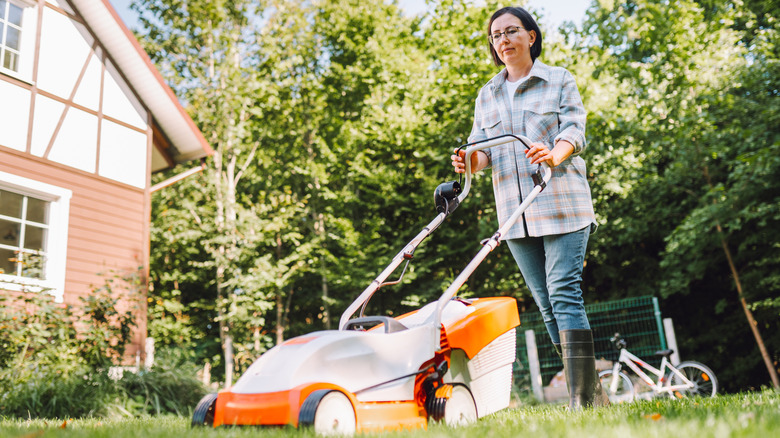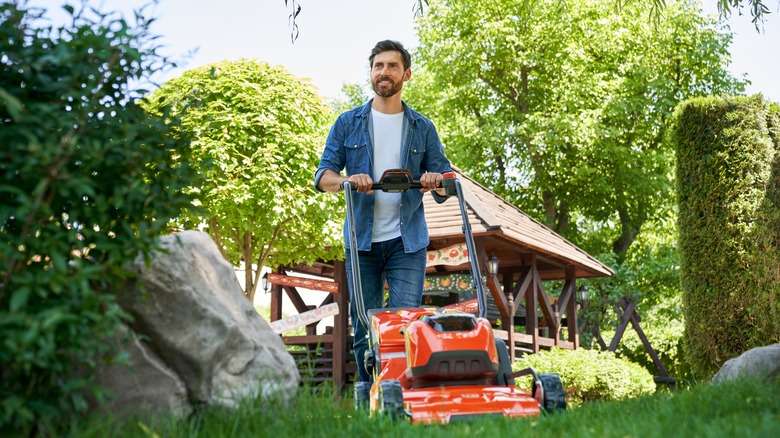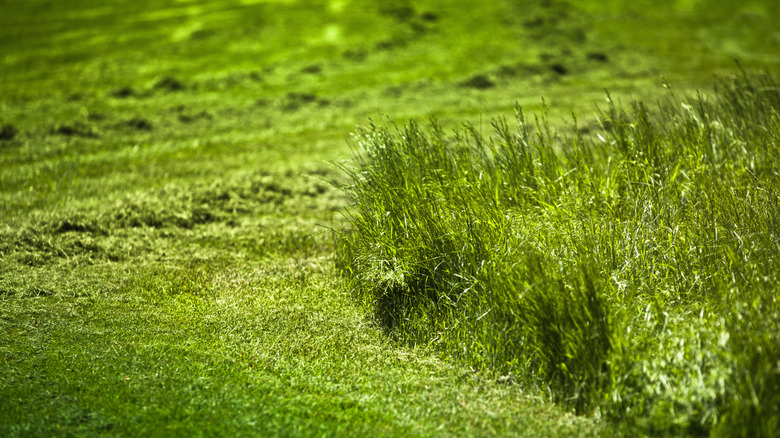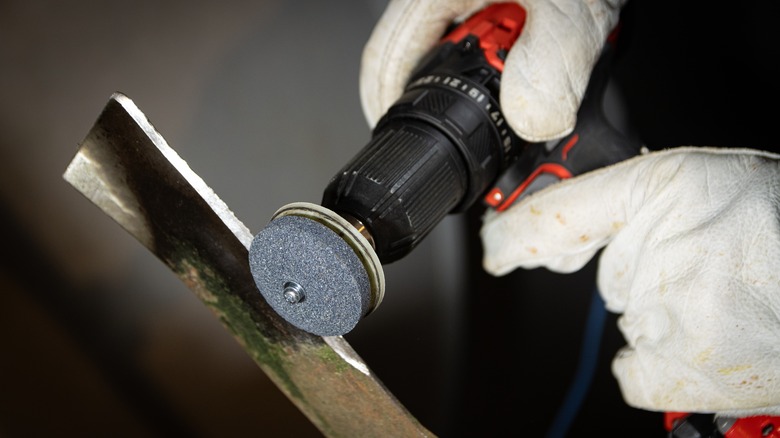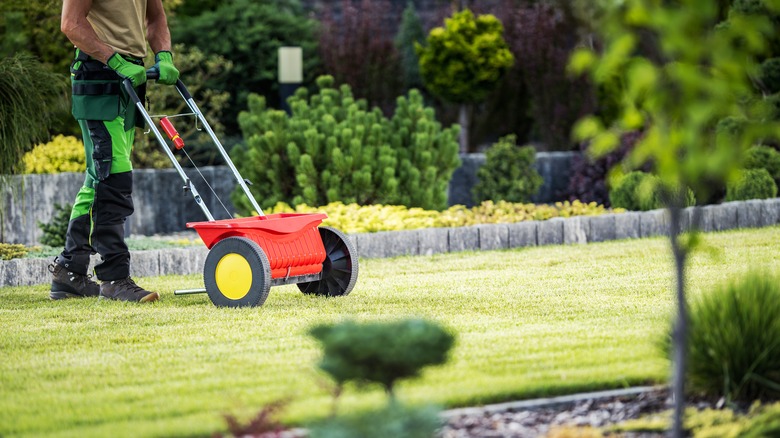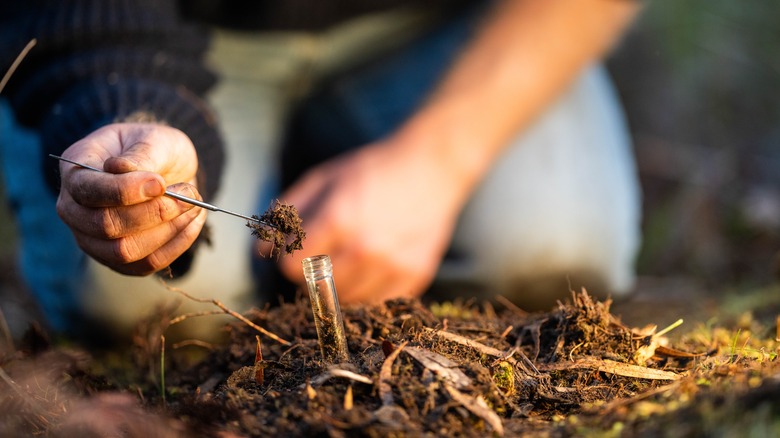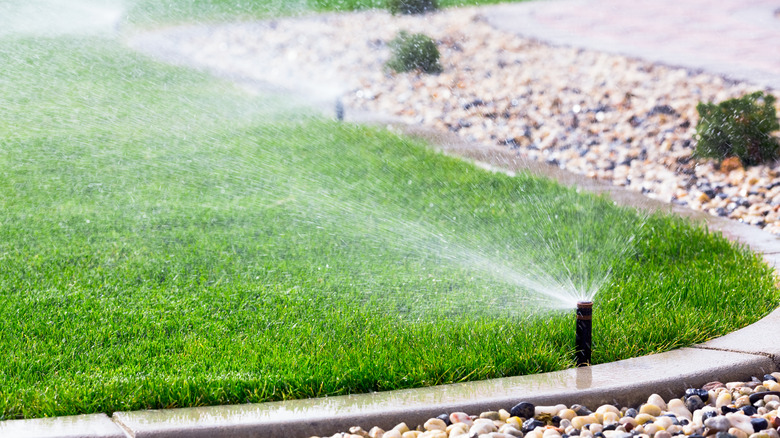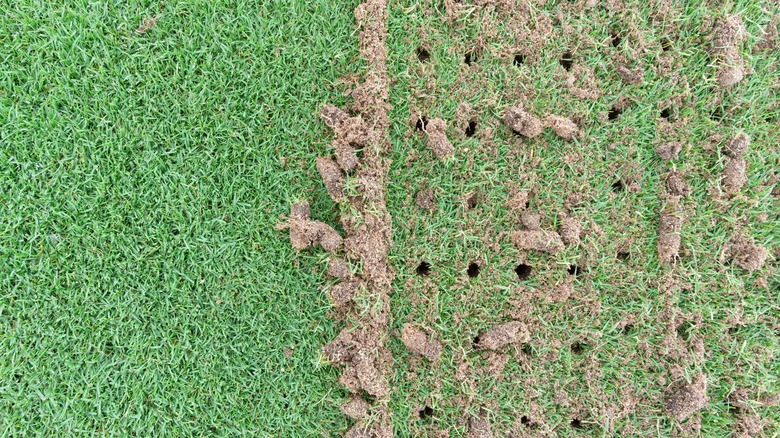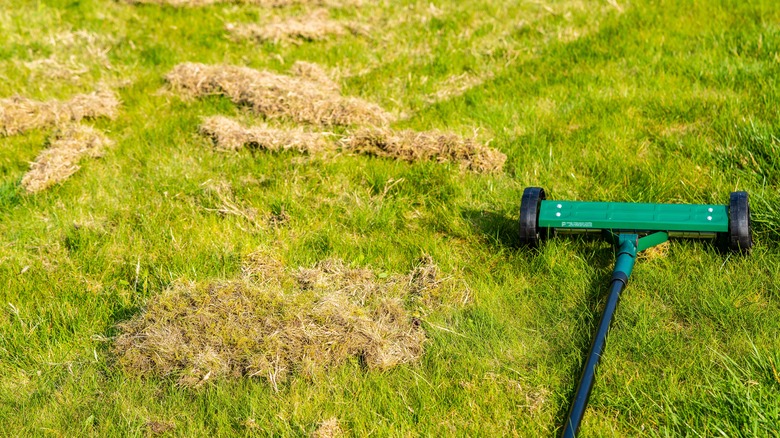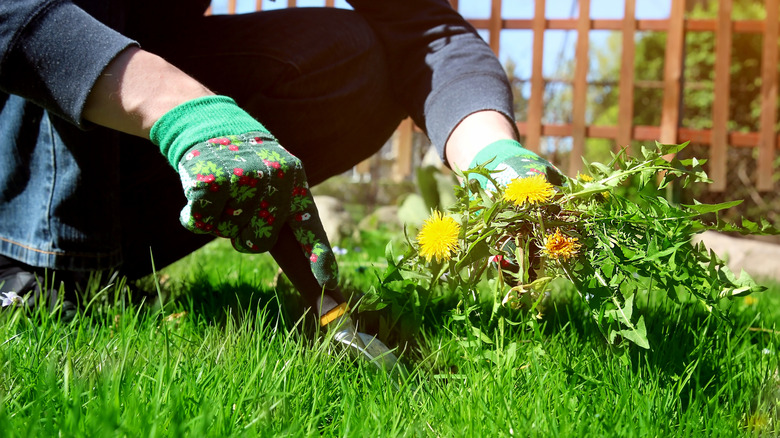11 Simple Habits Of People Who Keep Their Lawns Lush And Well-Manicured
We may receive a commission on purchases made from links.
Have you ever driven around your community and wondered why some of your neighbors' lawns look so much better than yours? They're lush, green, perfectly manicured, and obviously healthy. Meanwhile, your lawn has patches of brown and yellow grass and weeds scattered about. Plus, when you take a close look at it, the grass doesn't look even, despite the fact that you mowed just a few days ago.
Well, what gives? Do your neighbors have some sort of mythical grass-growing power that they're using to create that lush oasis surrounding their home? We're willing to bet that the answer is no. Instead, it's just likely that those with green, manicured lawns have well-established habits that help them keep their grass healthy.
If you're on a mission to transform the look and feel of your lawn, the smartest route is learning from those who have it all figured out. Believe it or not, many of the best insider lawn-tending secrets are not as involved as you may think. Ahead, we'll take a look at the habits of people who are able to maintain a healthy and well-manicured lawn, empowering you to get yours into tip-top condition as well.
They mow in response to grass length and growth rate, not the day of the week
Your friends and neighbors who maintain healthy turf know that there is no set answer to the question regarding how often you should mow the lawn. Instead, they plan their schedule based on the length of the grass in the yard and how quickly it is growing. Following this habit instead of always mowing on a set day of the week, keeps the grass from getting too long, ensures you don't cut it prematurely, and promotes healthy turf.
During the active growing season, grass should be mowed more frequently — possibly up to twice per week. However, when the weather heats up, and the grass goes dormant, less frequent mowing will be necessary. You can often cut back to once every seven to 10 days, or so. While getting into this habit can be challenging, and will likely involve some schedule modifications on your part, you'll reap the benefits when you start noticing the improved vigor of your lawn.
Tinkering with the blade height settings on their mowers
The owners of emerald green turf have also researched the ideal lawn mowing height instead of just starting up their mower and hoping for the best. Cutting the grass overly short,or keeping too long, can both have negative consequences. If too short of a cutting height is set, this can result in a shallower root system, and leave turf that's sparse, less resilient, and more prone to weed and pest infestations. Failing to cut off enough grass with each pass can also result in lower density and disease issues.
While you'll often hear advice to cut to a height between 2 and 3 inches, the optimal height for your lawn may vary based on the type of turfgrass that you have. For example, when mowing many warm-season grasses like Bermuda grass, centipede grass, or zoysia grass, you can choose a blade height between 1 and 2 inches. St. Augustine grass is one notable exception to this rule. Because of its much larger and coarser leaves, it stays healthiest when cut to a height between 2 ½ and 4 inches. Most cool-season grasses, such as tall fescue, will require a blade height between 2 and 3 ½ inches. Additionally, you shouldn't cut off more than one-third of the total height all at once. If you end up going a bit longer between mows because of a busy schedule, increase the blade height slightly for the first pass to avoid overcutting.
Not bagging up lawn clippings
You may assume that those with pristine lawns meticulously bag up their grass clippings. However, the opposite is actually true. Clippings are highly beneficial to the overall lawn health. As they break down, grass clippings can increase the nutrient and organic matter content of the soil.
Your neighbors who know this secret of leaving the clippings behind likely also know that a mulching mower is the best type to use. If you're wondering what's so different about a mulching mower (and do I really need one?), here's the low down. While a regular mower without a bag will leave clippings behind, the pieces of grass can form large clumps which can smother the lawn. Mulching mowers, on the other hand, ensure that each cut blade of grass is chopped into several tiny pieces. These won't clump together, will evenly spread out, and break down faster.
If yours is not a mulching mower, it might be worth looking into whether or not you can get a mulching blade attachment for it. For instance, Husqvarna sells a 46-Inch Mulch Kit for Lawn Tractor or Zero-Turn Mower models. If you are in the market for a new mower, the Ego Power+ Electric Lawn Mower is a well-reviewed mulching option.
They remember to sharpen their mower blades
Cutting the grass is such a crucial part of keeping a lawn healthy. So, it's not surprising that there's another mowing habit that lawn care pros have waxed — keeping their mower blades sharp. You shouldn't try to prune plants with dull shears, and the same is true for grass. You may assume that dull blades will simply make it more difficult to mow. While this is true, it isn't the only problem they can create. Dull blades can actually damage your lawn. Instead of neatly slicing through each piece of grass (like a properly sharpened blade will do), dull blades can tear, bruise, and shred the turf that they come into contact with. As you might guess, this isn't good for grass and may even cause the leaf blade edges to turn brown.
Here's how to how to know that it's time to sharpen your lawn mower blades: First, if the grass is looking torn or the tips are starting to brown, you can assume that the blades have dulled. A lawn that doesn't look even is also a sign that the blades may not be sharp enough. You can also inspect the blades themselves and look for any nicks or imperfections that will indicate the need for sharpening.
Before you begin sharpening, it is essential to pull out the wire from the spark plug to avoid accidentally turning on the machine. Then, you can turn the mower to one side, remove the blade, use a vise to hold it in place, and a file to sharpen. If you're not comfortable with completing this task on your own, a lawn equipment or repair shop near you may offer the service. Alternatively, you can pick up a kit to make the job easier, such as the Ankda Double Layer Corundum Lawn Mower Blade Sharpener.
They overseed sparse areas — and know the best time of the year to do so
People with lush and full lawns didn't get them by accident. They too likely faced the challenge of patches in their grass. The difference is that they have a game plan. Overseeding, which is when you apply new grass seed over existing turf, helps develop full lawns with fewer patches or sparse sections. However, you can't simply pick up a bag of seed from a local home improvement shop and just start throwing it over your yard. Instead, you must consider timing if you want the new seeds to germinate properly.
The ideal timing can vary based on the type of grass you have. If you have cool-season grass, such as tall fescue or Kentucky bluegrass, the best time to overseed will be in early fall. These seeds germinate when the temperature falls between 70 and 80 degrees Fahrenheit. Those who live in the south or other areas with warm season grass, such as zoysia grass or Saint Augustine grass, will want to overseed their lawn towards the end of the spring. These varieties do best with hotter temperatures, so waiting until the soil is warm enough will help ensure success. To increase germination, you might also want to opt for a grass patch repair kit, instead of just plain grass seed, such as the Scotts PatchMaster Lawn Repair Mix which includes grass seed, fertilizer, and mulch.
They get soil tests done and fertilize accordingly
If you just grab a random container of fertilizer from the store, it's time to learn another key habit that lawn care experts have mastered. Fertilizing shouldn't be a guessing game. Instead, the most reliable and beneficial approach is to conduct a soil test, which will reveal the levels of phosphorus, potassium, magnesium, and other nutrients as well as the pH of your soil, allowing you to identify its specific needs.
The best way to get a really conclusive, precise gauge on your soil is to send a sample in for a lab test. However, you can also try a home testing product, such as the MySoil Soil Test Kit. While at-home tests won't be as reliable, they can still help you make informed decisions when picking out fertilizers. When you look at a fertilizer bottle, you will see a series of three numbers, written like 10-10-10. These numbers indicate the concentration of nitrogen, phosphorus, and potassium. If your soil isn't lacking in phosphorous or potassium, an 11:2:2 mix like Scotts Natural Lawn Food should be fine. But if it's deficient in phosphorous, something like The Andersons Premium New Lawn Starter 20-27-5 Fertilizer might be a better choice.
They water slowly, deeply, and earlier in the day
The owners of all those pristine lawns you drive or walk by, also have a proper watering routine established. Instead of turning the sprinkler on every day for a few minutes, they understand that deeper, more spaced-out watering is the secret to vibrant and resilient lawn. While you might assume that people with beautiful green lawns water them day in and day out, that actually isn't the case, as watering frequently and lightly can weaken turf. If just the top of the soil is kept moist, the roots won't feel the need to penetrate more deeply into the soil. Shallow watering can also exacerbate weed growth, disease issues, and encourage grubs. To ensure water gets right down through the rootzone, at least the top 6 inches of soil should be damp after irrigating.
So how often, exactly, should you irrigate your turf? The answer will depend on how much rain you've had and how high the temperatures have been. If you observe any signs of drought in your grass, like a less vibrant color, or grass blades that are rolled or folded, it's definitely time to give your turf a long, slow, and deep soak. For garden beds and pot plants, sticking a finger down into the soil is one way to determine if it's time to water — but this isn't so easy with turf, especially if it's thick and well-established. To really dial in your watering, you could look into getting a simple hygrometer (you can pick up something like the Hathdia Soil Moisture Meter for under $7 on Amazon), which will give you an indication of how dry the earth is a few inches down into the root zone.
Knowing the best time of day to water a lawn is also important. Watering early in the morning helps ensure enough moisture is absorbed by the soil, but also prevents the blades of grass from staying too wet. Conversely, watering after the sun has gone down can increase the risk of some diseases. Finally, take care not to apply too much water too quickly, as it could cause erosion or runoff.
They routinely aerate their lawn
If you've never heard of aerating a lawn, you're not alone. Many people skip this lawn maintenance chore. But, you know who doesn't? That's right, the people who have healthy, green grass know the importance of aeration. Between rain, foot traffic, and other factors, the upper layers of the soil can become very compacted, making it difficult for roots to access water and nutrients.
Fortunately, the solution is as simple as learning how to aerate your lawn to create healthier grass. You can rent a plug aerator from a local landscaper or rental company and roll it across moistened soil. As you push the aerator, the plugs will pull out chunks of earth, allowing air, water, and organic matter to penetrate into the ground. Once you have aerated the soil, rake over some compost that will act as a top dressing and fill the holes.
If you have cool-season grass, you should aerate it in the fall. Early to mid-summer, on the other hand, is the best time to aerate warm-season grasses. Aerating right before overseeding can help you further maximize the benefits, as the seeds you spread will have greater odds of nestling into the soil thanks to all the little holes you just made. Word of warning, do not opt for a spiked aerator, as these types of tools can actually exacerbate compaction. If you only have a small patch of lawn and don't feel like renting a core aerator, you can also purchase a manual option, such as this Vanpein Lawn Aerator Coring Garden Tool, which buyers say works well for smaller yards.
They vertically mow their lawn when needed
Dethatching is another habit of people who keep their lawns lush and well-manicured. The term thatch, refers to a layer of partially dead roots, stems, and grass blades that's located between the base of the new blades and the top of the soil. Some amount of thatch is generally a good thing for lawns, but too much can be detrimental. Over time, thatch can build up, especially if you were a little too generous with the nitrogen fertilizer, the soil is quite compacted, or you've got a vigorous type of turf like Kentucky bluegrass or creeping bentgrass. When there's a lot of thatch present, it can limit how much water and air is able to circulate around the blades of grass, and create a hydrophobic layer, making it hard to properly water your lawn. Thick thatch can also trigger fungal disease.
So what does it mean to dethatch your lawn? It is the process of removing the build-up from the base of the grass, typically with a power rake or vertical mower. You can rent a power rake from places like The Home Depot, or — if you have a large yard with a grass species that's fast-growing and prone to thatch — buy your own. Something like the Wen DT1516 16-Inch 15-Amp 2-in-1 Electric Dethatcher and Scarifier is less than $170, which might be worthwhile, seeing as renting a dethatcher can run you around $90 a day. Alternatively, for small areas of lawn that don't have very thick thatching, you can also consider a manual dethatching rake, such as the Baraystus Thatch Rake. The early fall, when conditions are favorable for healthy grass growth, is generally the best time to dethatch. Do not dethatch too late into the fall, during droughts, or if the temperature is overly hot.
They inspect their lawn for weeds and remove them before infestations get out of hand
Weed control is another concept that the owners of beautiful yards have down to a tee. First, they know that weeds are less likely to occur in grass that's well taken care of, as weeds have a harder time taking root and spreading in dense turf. When weeds do pop up, these turf veterans act quickly. They're regularly inspecting their yard, so they are able to respond promptly and nip weed infestations in the (literal) bud.
When you catch weeds as they're just starting to grow, removing them is much easier. The root system will be smaller, and won't penetrate as deeply into the soil. Not only will yanking them out be less involved, but you'll likely have better success getting the entire root out. Besides this, if weeds are left unchecked and allowed to spread, they'll likely leave a bare patch when you do go to remove them — and any that go to seed will probably pop up all over your lawn and yard.
Hand-pulling is often the simplest way to route out weeds before they get a grip on your lawn. You can also opt for post-emergent broadleaf herbicides like Ortho WeedClear Weed Killer, a weed-and-feed product like Scotts Turf Builder Weed & Feed, or something like ECO Garden Pro Organic Vinegar Weed Killer for an environmentally friendly option. Lastly, pre-emergent products like Scotts Halts Crabgrass & Grassy Weed Preventer can stop weeds germinating from altogether, but do not apply when overseeding.
They train their dogs to go potty in areas where lawn spots won't be a problem
Did you know that your dog could be to blame for your grass turning yellow? Dog urine is very acidic. It also has a very high salt content. Because of this, the urine can burn lawn, stressing out the grass and turning it yellow. Sometimes, you may also notice a deeper green circle around the yellowing patch. This coloring is caused by the higher nitrogen content of the urine. However, people with lush lawns often have dogs too. They just do things a bit differently to avoid letting them damage the grass.
The best way to prevent a dog's urine from impacting the lawn is to prevent them from peeing there in the first place. Designate a section of the yard where you want your dog to urinate. One that is covered with gravel, mulch, or something else other than grass is ideal. Then, train your dog to only pee there. If you do see your dog pee on the lawn, you can minimize damage by deeply watering the area as soon as possible.

